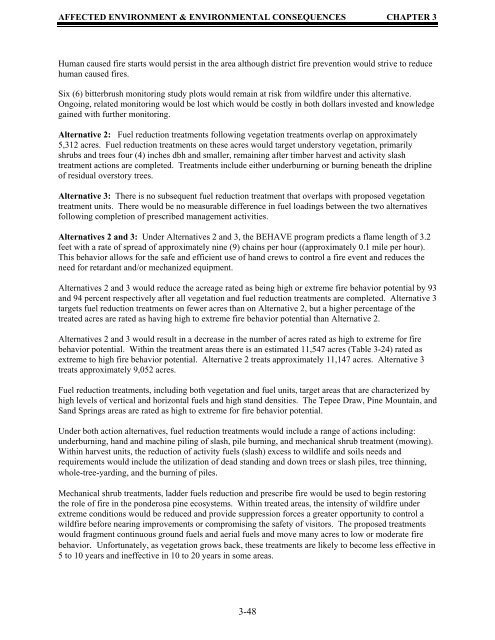Environmental Assessment
Environmental Assessment
Environmental Assessment
You also want an ePaper? Increase the reach of your titles
YUMPU automatically turns print PDFs into web optimized ePapers that Google loves.
AFFECTED ENVIRONMENT & ENVIRONMENTAL CONSEQUENCES CHAPTER 3<br />
Human caused fire starts would persist in the area although district fire prevention would strive to reduce<br />
human caused fires.<br />
Six (6) bitterbrush monitoring study plots would remain at risk from wildfire under this alternative.<br />
Ongoing, related monitoring would be lost which would be costly in both dollars invested and knowledge<br />
gained with further monitoring.<br />
Alternative 2: Fuel reduction treatments following vegetation treatments overlap on approximately<br />
5,312 acres. Fuel reduction treatments on these acres would target understory vegetation, primarily<br />
shrubs and trees four (4) inches dbh and smaller, remaining after timber harvest and activity slash<br />
treatment actions are completed. Treatments include either underburning or burning beneath the dripline<br />
of residual overstory trees.<br />
Alternative 3: There is no subsequent fuel reduction treatment that overlaps with proposed vegetation<br />
treatment units. There would be no measurable difference in fuel loadings between the two alternatives<br />
following completion of prescribed management activities.<br />
Alternatives 2 and 3: Under Alternatives 2 and 3, the BEHAVE program predicts a flame length of 3.2<br />
feet with a rate of spread of approximately nine (9) chains per hour ((approximately 0.1 mile per hour).<br />
This behavior allows for the safe and efficient use of hand crews to control a fire event and reduces the<br />
need for retardant and/or mechanized equipment.<br />
Alternatives 2 and 3 would reduce the acreage rated as being high or extreme fire behavior potential by 93<br />
and 94 percent respectively after all vegetation and fuel reduction treatments are completed. Alternative 3<br />
targets fuel reduction treatments on fewer acres than on Alternative 2, but a higher percentage of the<br />
treated acres are rated as having high to extreme fire behavior potential than Alternative 2.<br />
Alternatives 2 and 3 would result in a decrease in the number of acres rated as high to extreme for fire<br />
behavior potential. Within the treatment areas there is an estimated 11,547 acres (Table 3-24) rated as<br />
extreme to high fire behavior potential. Alternative 2 treats approximately 11,147 acres. Alternative 3<br />
treats approximately 9,052 acres.<br />
Fuel reduction treatments, including both vegetation and fuel units, target areas that are characterized by<br />
high levels of vertical and horizontal fuels and high stand densities. The Tepee Draw, Pine Mountain, and<br />
Sand Springs areas are rated as high to extreme for fire behavior potential.<br />
Under both action alternatives, fuel reduction treatments would include a range of actions including:<br />
underburning, hand and machine piling of slash, pile burning, and mechanical shrub treatment (mowing).<br />
Within harvest units, the reduction of activity fuels (slash) excess to wildlife and soils needs and<br />
requirements would include the utilization of dead standing and down trees or slash piles, tree thinning,<br />
whole-tree-yarding, and the burning of piles.<br />
Mechanical shrub treatments, ladder fuels reduction and prescribe fire would be used to begin restoring<br />
the role of fire in the ponderosa pine ecosystems. Within treated areas, the intensity of wildfire under<br />
extreme conditions would be reduced and provide suppression forces a greater opportunity to control a<br />
wildfire before nearing improvements or compromising the safety of visitors. The proposed treatments<br />
would fragment continuous ground fuels and aerial fuels and move many acres to low or moderate fire<br />
behavior. Unfortunately, as vegetation grows back, these treatments are likely to become less effective in<br />
5 to 10 years and ineffective in 10 to 20 years in some areas.<br />
3-48
















